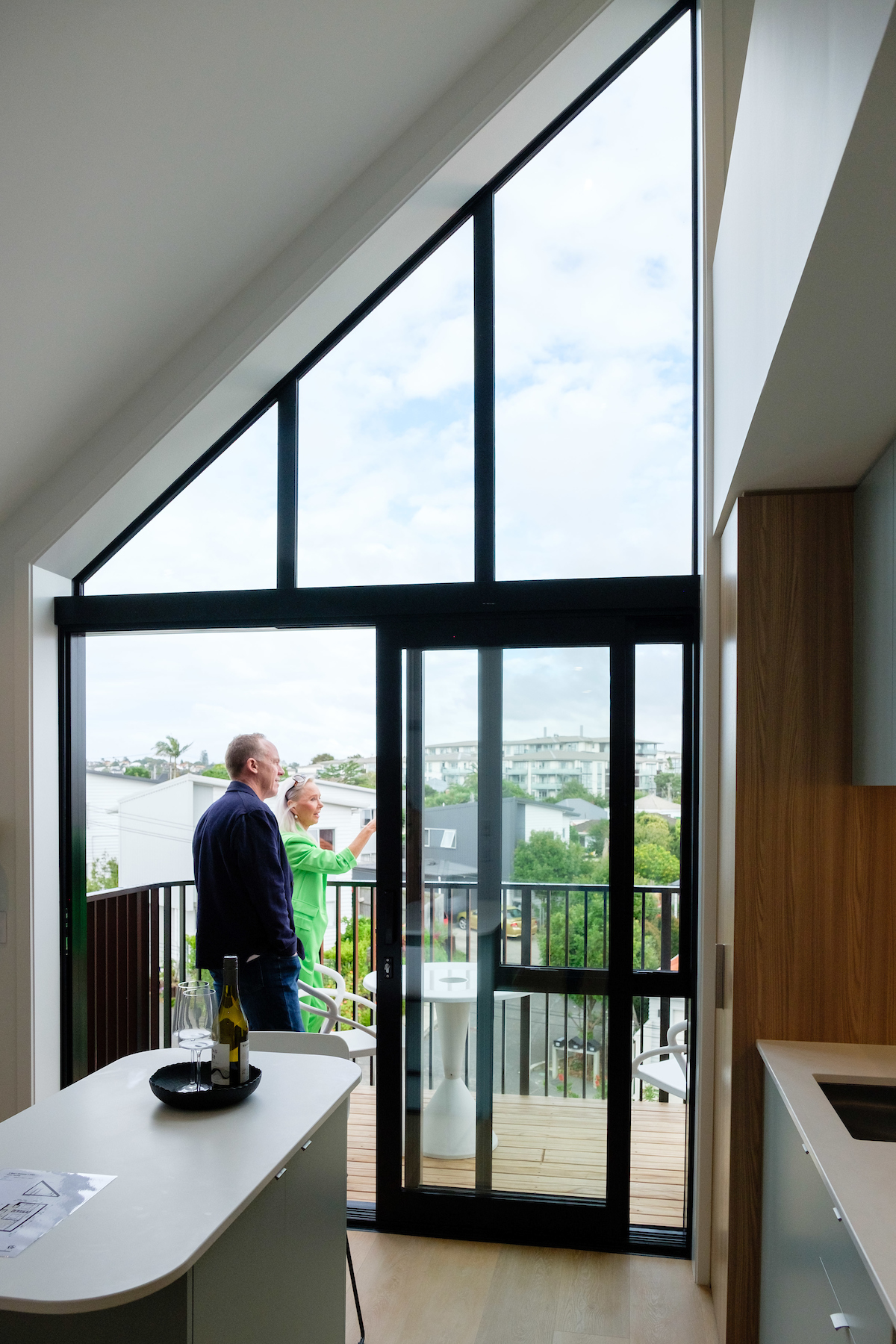We’ve just finished our 15th Auckland apartment development, a little Meadowbank marvel just two minutes from the train. On Friday 17 March, Deputy Mayor Desley Simpson formally opened Koa Flats, a building she lauded as “an example of intensification done incredibly well”.
17 Mar 2023
From Whoa to Koa: Deputy Mayor Desley Simpson Opens Ockham’s Latest
Resplendent in a neon-green St Patrick’s Day pant suit, the Deputy takes her place beside Koa Flat’s palm-fringed plunge pool. Alongside her, Koa architectural mastermind, Hannah Chiaroni-Clarke, proud, a little nervous, and at eight months-plus pregnant too tired to deliver a tirade herself. Instead, Ms Chiaroni-Clarke, is content to let her work do the talking: as the ceremony unfolds, her eyes, like those of others present, drift upwards to her creation.
It’s a simple building, three stories tall, its warm red brick façade a homage to the old-school brick homes from an earlier era. Koa has a traditional gabled roof, almost churchlike: inside soft, blue, watery hues echo throughout the design, reminiscent of the tranquil waters of the Ōrākei Basin and Auckland’s early evening skies.
It’d be foolish to suggest this understated block of 14 apartments is somehow an answer to Auckland’s housing crisis. But the simple, repeatable design of Koa – its elegance, its scale, its sturdiness – offers a template of considered intensification that fits the soul and fabric of the surrounding community.
A quality, compact city…
Ockham captain Mark Todd spoke first. “It’s the smallest development we’ve undertaken,” he says. “Small-but-perfectly formed as our sales team like to say. But Koa Flats is notable in a number of ways.”
Situated just 400 metres from Meadowbank Train Station, Koa Flats is the first project consented under the new Mixed Housing Urban (MHU) zone, which permits three-story developments without density controls in areas with excellent public transport amenity.
And it speaks, Todd argues, to the central aim of the Auckland Unitary Plan, the city’s blueprint: to build ‘a quality, compact city’.
“This is a 632 sq/m site in an incredible location,” he says. “Ordinarily, in Meadowbank, it’d have two or three terrace houses stuck on it, each costing $1.8 and $2.2 million dollars in Meadowbank. That’s the usual model that’s been done to death.
“And my view is that this lacks imagination. Lacks ambition. Instead, we’ve turned one ex-state house on this site into 14 one and two bedroom units. Fourteen units priced between $635,000 and $935,000 – that’s four times the housing supply at maybe 35% of the average value.”
“Hugely fantastic suburb, great schools – it's exactly what we want to see in Auckland… Job well done. This is the future. Do more of it, please.”
Deputy Mayor Desley Simpson
In thrall to sprawl
A consistent critic of Auckland’s urban sprawl, Todd has argued the environmental costs and ballooning infrastructure bills of an ever-expanding city are unsustainable. He supports the Unitary Plan’s vision that envisages 70% of Auckland’s new housing over the next 30 years being built within the existing urban boundaries.
“People sometimes forget how massive Auckland City is,” he says. “Geographically it’s already the size of London.
“A city with no limits – an Auckland that endlessly sprawls and devours thousands of acres of farmland and bush each year is a discredited, last century, LA-style dystopia. It’s neither sustainable nor affordable nor desirable – more and more motorways are just roads to nowhere.”
Instead, Todd says, a core Ockham principle is to build in the high value areas where people want to live. Importantly, Koa presents a several options for its residents that are not always seen in urban regeneration projects. “It helps older people downsize and stay in the area. It helps younger people afford to be in the area. It’s really good for the avoidance of socio-economic stratification and choice in neighborhoods. And also density because that's how we get our mass transit and cycle networks working.
“Koa Flats has carparks. But when you’re two minutes’ walk from a train station that’s just two stops – seven minutes – from the CBD, why would you bother driving?”
A superb building in objectively the finest suburb on Planet Earth
Deputy Mayor Desley Simpson, who is also the councillor for the Ōrākei Ward, was up next, the keynote speaker.
“I just want to offer my absolute congratulations to you,” she says. “Not only is this intensification done incredibly well, but it's right next to arguably the best walkway/cycleway in Auckland.”
Deputy Desley is referring, of course, to the stunning Te Ara Ki Uta Ki Tai – the Path of Land and Sea – which is very probably the most mediative, zen-like meander in the city.
“This building is built by the train station, beside this fantastic walkway/cycleway which means the people who live here can walk or cycle all the way – off-road – into the city…
“It’s simply design done well.”
And if also offers a constructive alternative to the many Aucklanders, who unenthused by sausage flats and crappy developments, have found themselves labels NIMBYS. "You talk about NIMBYism?” the Deputy asks rhetorically. “You know what people don't like to see – I think it's been called ‘Stalinist-style developments’.
There's no way you could describe these apartments – these flats – as Stalinesque in any way. Hannah: you have done exceptionally well. They've got fantastic storage in them – you've been so creative how you’ve brought storage into the ceiling and alongside the walls. It's got great appliances. “I just think you've done an outstanding job."
In sum: “Hugely fantastic suburb, great schools – it's exactly what we want to see in Auckland. “So I just want to give my huge thanks to the Ockham team, all of you. Job well done.
“This is the future. Do more of it, please.”
Topics































